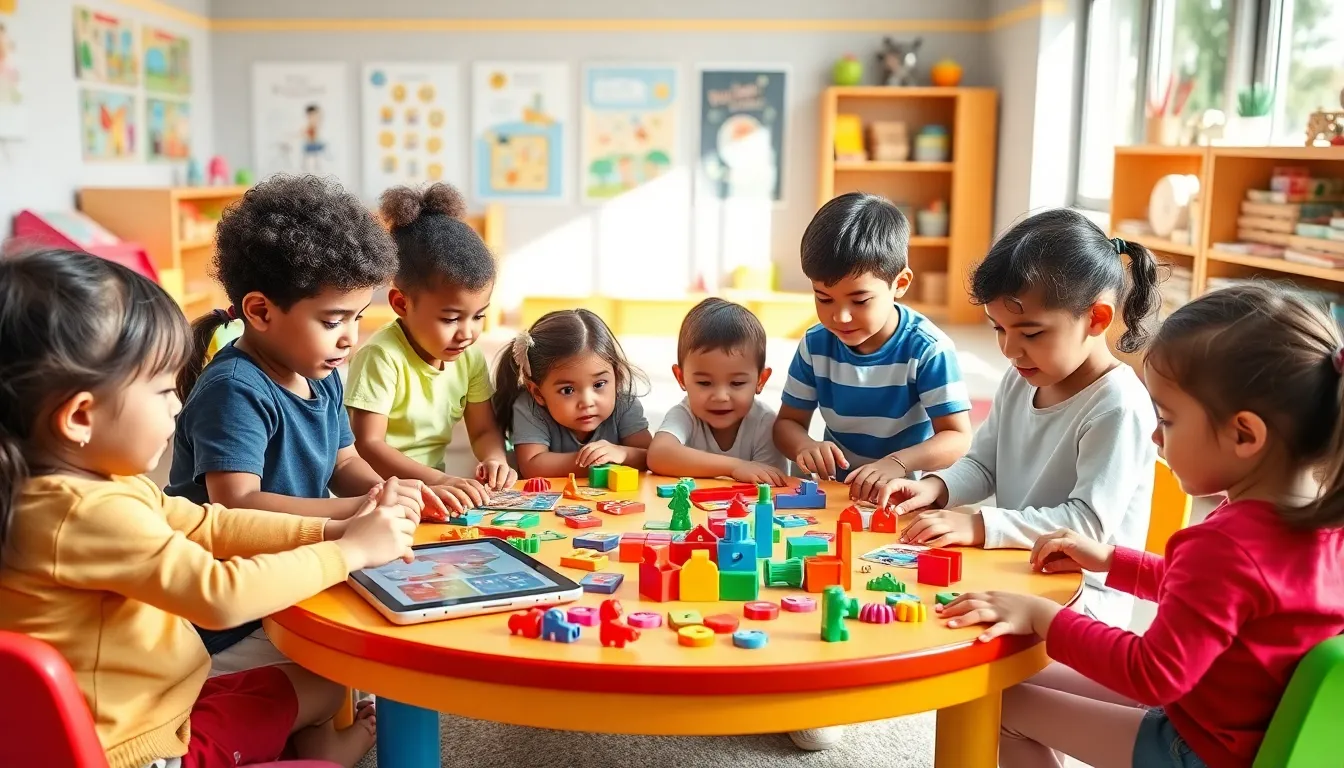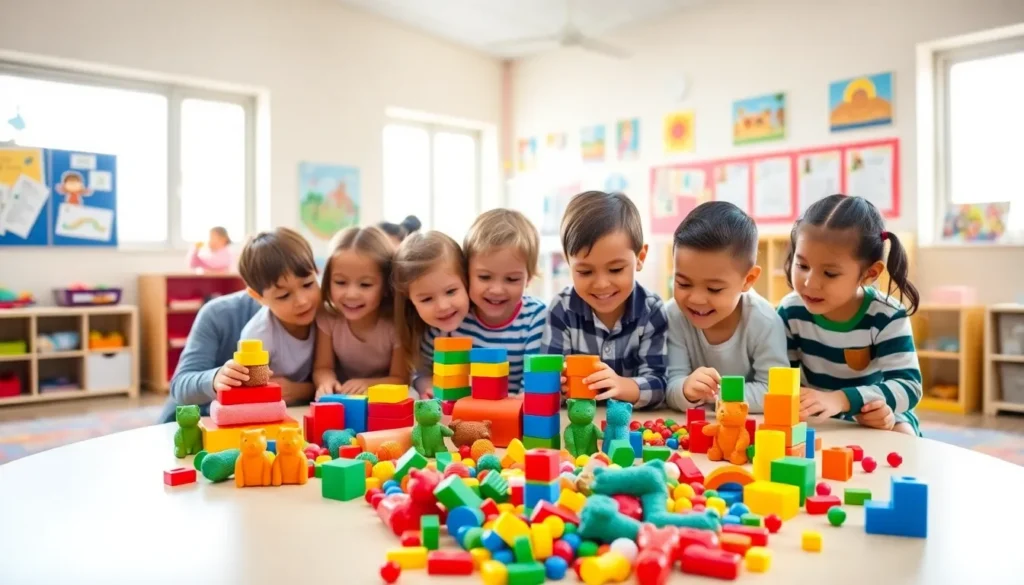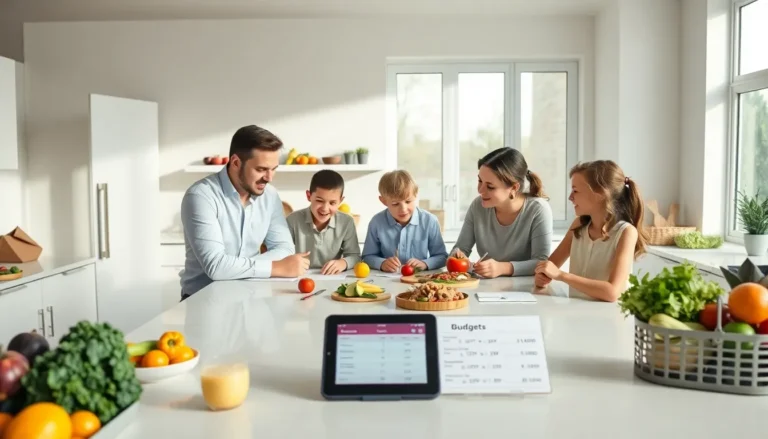Table of Contents
ToggleImagine a classroom where learning feels like play. That’s the enchanting world of manipulatives in preschool. These hands-on tools aren’t just about keeping little hands busy: they’re a secret weapon in the fight against boredom, transforming abstract concepts into tangible experience. Whether they’re stacking blocks or sorting vibrant beads, preschoolers are not only having fun, they’re developing crucial skills. Join us as we investigate into the world of manipulatives, why they matter, and how they can elevate early childhood education from ordinary to extraordinary.
Understanding Manipulatives

Manipulatives are physical tools or objects that children can touch and move to explore concepts and solve problems. These resources can range from simple items like blocks and counting bears to more complex tools like pattern tiles and interactive digital games. They engage a child’s senses, making learning a hands-on experience. Manipulatives help cognitive growth as they encourage creativity and critical thinking. By interacting with these tools, children can visualize ideas and concepts in ways that traditional teaching methods may not allow. This multi-sensory approach taps into various learning styles, making it accessible for all preschoolers.
Importance Of Manipulatives In Early Childhood Education
The significance of manipulatives in early childhood education cannot be overstated. They provide an interactive learning experience that fuels curiosity and encourages exploration. When preschoolers use manipulatives, they engage in hands-on learning that appeals to their natural desire to investigate and discover. Research shows that early experiences with manipulatives enhance problem-solving skills and mathematical reasoning. Besides, these tools promote social interactions among peers by facilitating group work and collaborative play. In essence, manipulatives not only build foundational skills in literacy and numeracy but also nurture a child’s ability to work effectively with others.
Types Of Manipulatives For Preschoolers
When it comes to manipulatives, variety is the spice of life. Here are key types that every preschool classroom should consider:
Choosing The Right Manipulatives
Selecting the right manipulatives hinges on educational goals, the child’s developmental stages, and personal interests. Look for tools that foster engagement and cater to different learning styles. Incorporating diverse manipulatives not only maintains interest but also addresses multiple areas of development such as fine motor skills, social skills, and cognitive growth.
Physical Manipulatives
Physical manipulatives encompass tangible items that children can hold, move, and manipulate. They include blocks, clay, puzzles, and counting cubes. These tools help preschoolers understand patterns, shapes, and basic math concepts through exploration and play. For instance, building with blocks enhances spatial awareness and encourages creativity, while sorting activities with colorful beads develop early counting skills.
Digital Manipulatives
In today’s tech-savvy world, digital manipulatives are gaining popularity in preschool settings. Interactive apps and software offer engaging ways to introduce complex concepts like numbers or phonetics through games and simulations. These digital tools can be particularly useful for children who may struggle with traditional learning methods. But, balance is key: incorporating physical manipulatives alongside digital tools can ensure a well-rounded learning experience.
How To Incorporate Manipulatives Into Learning Activities
Incorporating manipulatives into learning activities is both an art and a science. Here’s how educators can seamlessly blend these tools into their daily routines:
- Thematic Learning: Integrate manipulatives into themes being explored. If children are learning about animals, provide figurines representing various species. They’ll have fun while enhancing vocabulary and social skills through storytelling.
- Center Activities: Design specific areas in the classroom dedicated to manipulatives. Create math, science, and art centers where children can access tools that relate to their ongoing work.
- Guided Instruction: During lessons, demonstrate how to use manipulatives to solve problems. This direct instruction can support children’s understanding and application of concepts in real time.
- Open-Ended Exploration: Allow time for free play with manipulatives. This unstructured time encourages creativity and innovation, helping preschoolers to connect their experiences with concepts learned in class.
Benefits Of Using Manipulatives
The myriad benefits of using manipulatives in preschool are not just fluff: they’re backed by educational research. Here are some standout advantages:
- Enhanced Engagement: By providing interactive opportunities, manipulatives keep children engaged and focused.
- Critical Thinking Skills: Using these tools prompts preschoolers to analyze and make decisions, which cultivates cognitive development.
- Fine Motor Skill Development: The physical act of manipulating objects refines hand-eye coordination and builds necessary motor skills.
- Social Skills Development: When children work with peers, they’re developing vital communication, collaboration, and conflict resolution skills.
- Confidence Building: Successfully using manipulatives for problem-solving boosts self-esteem and fosters a love of learning.
Tips For Parents And Educators
For parents and educators wanting to maximize the benefits of manipulatives, consider these practical tips:
- Choose Quality Over Quantity: Opt for high-quality, diverse manipulatives that spark interest and offer multi-purpose use.
- Be Observant: Watch how children interact with manipulatives to gain insights into their learning styles and preferences.
- Encourage Exploration: Provide opportunities for children to experiment with different ways of using manipulatives. Curiosity is a powerful teacher.
- Make Connections: Help children link manipulatives to other areas of learning. For example, while sorting blocks, discuss colors and shapes to enhance learning.
- Involve Families: Encourage parents to use simple manipulatives at home, such as measuring cups during cooking, to reinforce skills in everyday activities.





